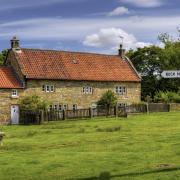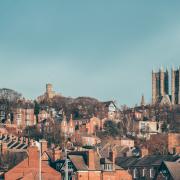Pride and creativity are the cornerstones of life in the historic West Riding market town says Chris Titley Photographs by Elizabeth Savage and John Cocks
Pontefract’s MP, former Cabinet member and current Shadow Home Secretary Yvette Cooper, calls her constituents ‘hardworking people who are proud of their strong communities and who have fought hard across generations to defend them’. That pride is evident to any visitor. Despite being hit hard by the loss of traditional industries, not least the coalfields, Pontefract remains a handsome town.
The town centre, one of the earliest to be pedestrianised, is dotted with historic buildings. Pontefract’s imposing market hall, rebuilt after a fire in 1957, and the Buttercross, built from suitably creamy-coloured stone in 1734, stand as testament to the fact that Pontefract has been a market town for centuries.
The area’s ability to cultivate a particularly toothsome root is recalled in both the street and pub names: Liquorice Way is only a short walk from the Liquorice Bush pub. Locally-grown liquorice may be a thing of the past, but the town has retained sweet-making factories and stages an annual liquorice festival. Perhaps the sense of pride and independence that Yvette Cooper referred to was forged in the castle. Once the most impressive in the North of England, King Richard II is said to have died here, and it was besieged three times during the English Civil War.
Nearby All Saints’ Church also suffered in the bombardment. Today you are less likely to see cannonballs hurtling through the Pontefract sky. But the people are still battling for their town. Among them are the highly active members of Pontefract Civic Society. It’s secretary, Paul Cartwright, said they keep an eye out for when buildings are in a state of disrepair or shop chains hang up unsightly banners, and work with the council’s conservation officer to put things right.
‘We think it makes the town more attractive, not just for the local population, but as a place for visitors,’ he said. ‘If people are coming into Pontefract it’s for a specific reason: it could be the heritage, it could be the castle, it could be Pontefract races – as well as the local market which is reputed to be one of the best in the Wakefield district. Having a town centre that is attractive and buildings that are well presented makes the town more appealing.’
Pontefract has four distinct conservation areas, and historic buildings from the medieval, Georgian, Victorian and Edwardian periods. But this isn’t its only appeal to visitors.
‘The people are friendly. I would say businesses are thriving: I don’t think that we have as many empty shops as in other high streets.’
The civic society has always campaigned for Pontefract. It was instrumental in ensuring the streets were paved with high-quality stone rather than concrete when first pedestrianised. It put its weight behind a successful crusade to redevelop the hospital and is actively engaged in trying to improve the town’s three railway stations and the train services that use them.
‘We’ve just helped establish a new friends group for a lovely historic park which is right in the town centre, Friarwood Valley Gardens,’ said Paul.‘We’ve helped campaigns with the local authority and Friends of the Castle to get investment from the lottery fund, and that’s run into millions.’
If the society can keep working with the council, property companies and other stakeholders, he is optimistic about the future. ‘We’re quite upbeat and will continue to make sure we’re providing a voice for the town as a whole to make Pontefract more prosperous.’
Artist Brian Lewis arrived in the town aged 20 when he got married following National Service. That was 55 years ago.
A former director of the Yorkshire Arts Circus, Brian is a co-founder of publisher Pontefract Press, and is leading light in the town’s creative community.
He’s heading towards the end of an ambitious project which will see him complete a thousand drawings in a year. When finished his work will be exhibited at Dean Clough in Halifax, including a large mural of some of the pictures.
‘I’m taking the structure of the Japanese painting, Hokusai’s The Wave, and I’m making it in a series of my own drawings,’ he explained.
The compact size of the town engenders pubsan artistic spirit, Brian believes. ‘I get my drawings framed in the market place by a man who charges me �10 a frame. This is what you want. I’m a big localist.
‘Within five minutes’ walk I can always find the people I need. Across the road lives a designer.
‘Up on Banks Avenue there are at least two photographers who are at exhibition standard, and one sells his prints for �1,400.
‘All this is in the town. Nobody knows about them.’He compares Pontefract to Athens at the time of Socrates ‘They’re about the same size.
‘And if I sit in the market place long enough, Socrates, Euripides, Aeschylus, Pericles and all the others will come up and talk to me. It’s all about scale.’
Brian has often worked to promote other artists, organising the first exhibition of work by Harry Malkin, the coal miner turned artist who recently unveiled a memorial to the men and boys who died in Allerton Bywater Colliery.
‘His first exhibition was between the lavatory and the till at an underground restaurant in Pontefract,’ Brian recalled. ‘But it was an exhibition. Then one of my colleagues said I’ll try to get you an exhibition as well.
‘She wrote to the Royal Festival Hall in London – and his second exhibition was there.’
Getting there: Pontefract is well connected, located to the south of the M62 and the west of the A1. It also has three railway stations, with two trains an hour from Leeds to Pontefract Monkhill
Where to park: There are more than 800 off-street car parking spaces in or around Pontefract Town Centre. Try Newgate South long stay
What to do: Soak up the history at Pontefract Castle and see where Civil War prisoners carved their names into the cell walls. Have a flutter at the racecourse – the longest flat, circular course in Europe. And then seek refreshment at one of the town’s surfeit of historic pubs


























